国际商务英语串讲讲义
- 格式:doc
- 大小:39.00 KB
- 文档页数:4
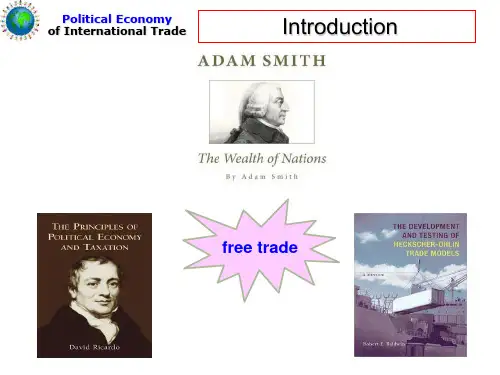
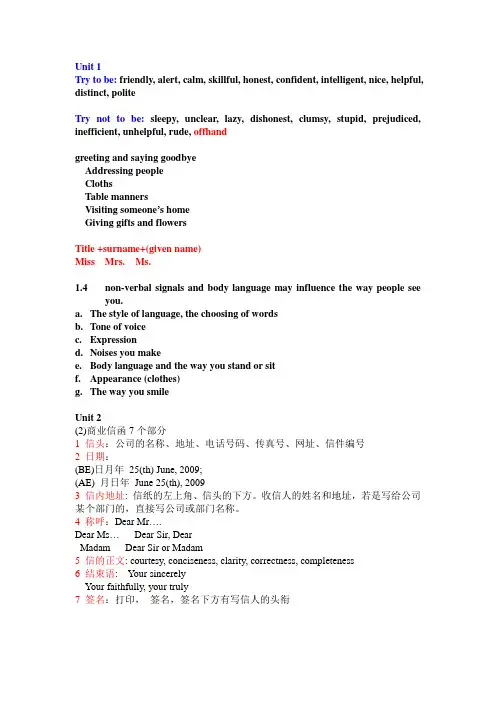
Unit 1Try to be: friendly, alert, calm, skillful, honest, confident, intelligent, nice, helpful, distinct, politeTry not to be: sleepy, unclear, lazy, dishonest, clumsy, stupid, prejudiced, inefficient, unhelpful, rude, offhandgreeting and saying goodbyeAddressing peopleClothsTable mannersVisiting someone’s homeGiving gifts and flowersTitle +surname+(given name)Miss Mrs. Ms.1.4non-verbal signals and body language may influence the way people seeyou.a.The style of language, the choosing of wordsb.Tone of voicec.Expressiond.Noises you makee.Body language and the way you stand or sitf.Appearance (clothes)g.The way you smileUnit 2(2)商业信函7个部分1 信头:公司的名称、地址、电话号码、传真号、网址、信件编号2 日期:(BE)日月年25(th) June, 2009;(AE) 月日年June 25(th), 20093 信内地址: 信纸的左上角、信头的下方。
收信人的姓名和地址,若是写给公司某个部门的,直接写公司或部门名称。
4 称呼:Dear Mr….Dear Ms…Dear Sir, DearMadam Dear Sir or Madam5 信的正文: courtesy, conciseness, clarity, correctness, completeness6 结束语: Y our sincerelyY our faithfully, your truly7 签名:打印,签名,签名下方有写信人的头衔Common abbreviations& Co. =and company@ =at(a price of)..a/c = accountadmin. = administrationapprox. = approximatelyASAP or asap = as soon as possibleattn = for the attention ofb/f = brought forwardc.c. = cubic centimetrec.c. / cc = carbon copy (photocopy)c/f = carried forwardc/o = care ofCEO = chief executive officerCorp. = Corporationdept. = departmentdo = ditto (the same)doz. Or dz. = dozenea. = eachenc./encl. = enclosureetc. = and so onft = foot/ feetincl.= including / inclusivelb / lbs = pound(s)i.e./ ie = that isInc. = incorporatedLtd. = LimitedMD = managing directorMisc. = miscellaneousN/A = not applicableNo.(US#) =numberoz. = ouncep.a. = per annum/ per yearp.p. = per pro (on behalf of )PA = personal assistantPC = personal computerplc/p.l.c. = public limited corporationPOB = Post Office Box PS/P.S. = postscript Rd = roadrecd = receivedref. = referenceSq. = squareSt. = streetyd / yds = yard(s)R = Registered trademarkC = copyrightTM = trade markUnit 33.2 Getting people to do thingsrequesting: agreeing to or refusing requestsoffering to help:accepting or rejecting offersasking permission:giving or refusing permissionunit 4•City college of Wuhan University of Science and Technology•Special No.1 Huang Jia Da Wan•East Lake Scenery District•Wuhan•Hubei 430083•China4.1 Amake notes & take notes•Note-making: noting down ideas before writing a report or letter or before a phone call or meeting. 打底稿,写笔记•Note-taking: taking notes after or during a conversation or meeting. 做记录4.2 reportA good report•is well researched and logically presented•provides enough information to enable decisions to be made•uses a style appropriate for the purpose•is accurate, clear and concise•supports all claims and conclusions with evidence4.3 planning and editing a report•When planning a report there are two main points to consider:•1. the purpose•2. the readerA Procedure of making report•Assemble the material•Plan the report•Draft the report•Edit the reportStructure of the report•Title page•Table of contents•Summary•Terms of reference•Procedure(interviews, meetings,published sources, observation,visits,questionnaires,scientific measurement)•Findings (main part)•Conclusions•Recommendations•Appendices•Bibliography/ReferenceUnit 55.1 workplace•A business organization can be defined as a firm, a company, a business or a corporation that makes, buys or sells goods, or provides services, to make a profit. 5.2 different kinds of company•Sector行业: a part of economy•Industry产业:organized activity producing goods or services, for example food, banking, construction, steel, tobacco and biotechnology.•Primary—oil,agriculture, fishing, mining, construction•Secondary—crafts and manufacturing•Teriary—services, including education, banking, insurance, tourism, leisure, etc.••UK US•Board of DirectorsChairman PresidentManaging Director Chief Executive OfficerDeputy Managing Director Vice PresidentGeneral Manager DirectorDepartment Manager ManagerAccountant Financial ControllerUnit 7The concept of international trade●International trade, also known as world trade, is the fair and deliberate exchange of goods and services across national boundaries.It concerns trade operations of both import and export and includes the purchase and sale of both visible and invisible goods.6.1 exchanging information●V ersion 1-hostile, aggressive,impatient, informal●V ersion 2-friendly, helpful, formal, polite●Their tone of voice, the way they hesitate, the polite forms they use6.4 Placing and filling ordersOrders—fax /letter1. 感谢对方的报盘或样品,表示愿意定购2. 对商品加以详细说明,主要包括数量、货号、价格3. 说明包装方式、目的港及运装期Acknowledging of the order1. 对收到订单表示高兴2. 重复订单的条件3. 交货、寄送单据等4. 希望再次合作Unit 87.2 cash flow•Cash: money in notes and coins•Currency: coins and banknotes of a particular country•Cash flow: refers to the movement of cash into or out of a business, a project, or a financial product. It is usually measured during a specified, finite period of time.。
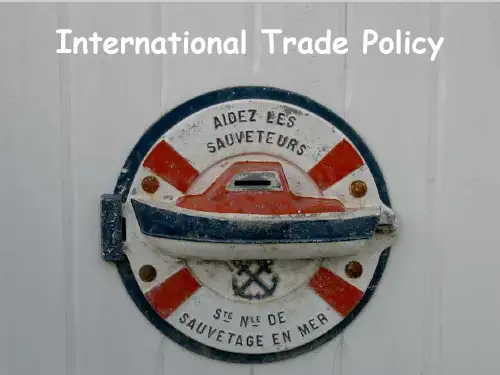
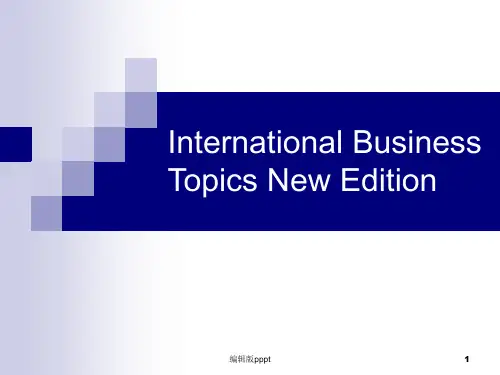
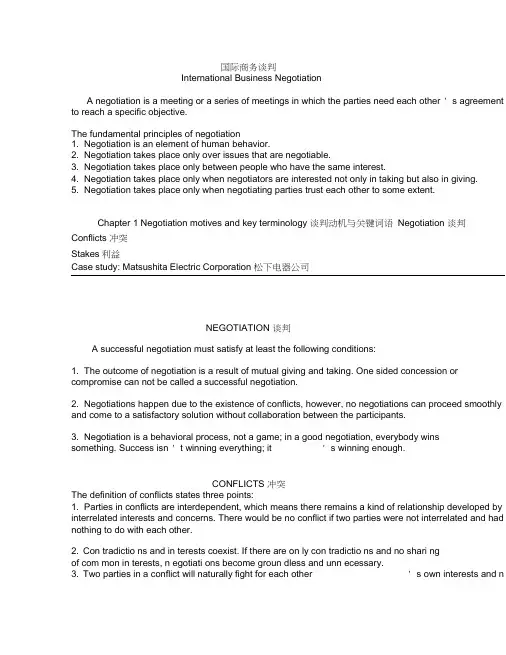
国际商务谈判International Business NegotiationA negotiation is a meeting or a series of meetings in which the parties need each other ' s agreement to reach a specific objective.The fundamental principles of negotiation1. Negotiation is an element of human behavior.2. Negotiation takes place only over issues that are negotiable.3. Negotiation takes place only between people who have the same interest.4. Negotiation takes place only when negotiators are interested not only in taking but also in giving.5. Negotiation takes place only when negotiating parties trust each other to some extent.Chapter 1 Negotiation motives and key terminology 谈判动机与关键词语Negotiation 谈判Conflicts 冲突Stakes利益Case study: Matsushita Electric Corporation 松下电器公司NEGOTIATION 谈判A successful negotiation must satisfy at least the following conditions:1. The outcome of negotiation is a result of mutual giving and taking. One sided concession or compromise can not be called a successful negotiation.2. Negotiations happen due to the existence of conflicts, however, no negotiations can proceed smoothly and come to a satisfactory solution without collaboration between the participants.3. Negotiation is a behavioral process, not a game; in a good negotiation, everybody winssomething. Success isn ' t winning everything; it ' s winning enough.CONFLICTS 冲突The definition of conflicts states three points:1. Parties in conflicts are interdependent, which means there remains a kind of relationship developed by interrelated interests and concerns. There would be no conflict if two parties were not interrelated and had nothing to do with each other.2. Con tradictio ns and in terests coexist. If there are on ly con tradictio ns and no shari ngof com mon in terests, n egotiati ons become groun dless and unn ecessary.3. Two parties in a conflict will naturally fight for each other ' s own interests and nevery effort to gain more from the other side, as a result it will reduce gain of interestsexpected in itially.STAKES利益Stakes are the value of ben efits that may be gained or lost, and costs that may bein curred or avoided. Four points n eed to be clarified:1. Negotiation parties will either gain the interests they expect to win from then egotiati on or lose what they hope to attai n, which in dicates that the talks are pert inent to releva nt parties ' own affairs and in terests. Only whe n a party has stakes conn ected with the issues to be talked, can it become actively engaged in the negotiation.2. Free lunch is not provided at the n egotiati on table, in ano ther word, to get what is desired, both parties have to pay for the gaining at either high cost or low cost depe nding on how well n egotiators man age the situati on.3. The n egotiators will have to decide how much of stakes can be gained and whether a particular gain is the one that a party desires for. They will also have to decide how much they may gain if they choose opti on A in stead of opti on B.4. Negotiators will have to compare and bala nee the relati on betwee n the curre nt in terests and long term in terests or un derly ing desires in order to make decisi on on satisfy ing long term interests at the cost of current interests.Effective negotiati ng (VCD)成功谈判Who s who in Effective NegotiationThe compa niesLevien SA , based in Brussels, Belgium.It is an intern ati onal compa ny which manu factures specialist paints and dyes.In its head office it has a small IT function which the company has decided to outsource.Okus IT, based in Swindon, in the South of En gla nd.They specialize in managing IT projects and taking over the IT departments of theirclie nt compa ni es.The n egotiati onOkus have sent a detailed writte n proposal to Levie n.The meet ing has bee n arran ged to n egotiate the terms of any agreeme nt.In particular the following two issues are likely to be sticking points:1. StaffingLevien would like to protect the jobs of their current IT team.They want Okus to employ the four members of the team, and are under pressure from the unions to make sure outsourcing contracts like this do not lead to redundancies.Okus, on the other hand, will not want totake on Levien ' s whole team.They already have project engineers based in Swindon.2. PricingOkus have proposed two levels of IT support: Level AA fixed monthly price which will cover all support work (daily maintenance and customer support) and specified project work (hardware and software upgrades, training. Etc.) Level BA lower monthly invoice based on just support work. Any additional project work will be logged and then added to the invoice the following month.1. Preparing the groundThe peopleAndrew Carter is Export Sales Manager for Okus IT. He has made the initial contact with Levien. He has met one of the Levien team, Sean, before.Karen Black is a Project Manager at Okus IT. She has prepared the specifications for this contract. This is the first time she has been involved in negotiating an overseas outsourcing contract. She is anxious about the meeting.Francoise Quantin is the current IT Manger at Levien. She is about to be promoted to Head of Logistics. She is keen that her IT team are protected.Sean Morrissey is from Levien ' s main subsidiary in Chicago. He has been sent to the Brussels Office to develop Levien ' s procurement policy.The negotiationAs the VCD begins, Andrew and Karen have arrived at Levien 'osffices and are waiting to meet Francoise and Sean.Script 1Karen Black and Andre Carter fail to communicate before they meet the Levin team.A =Andrew K =Karen F =Fran?oise S =SeanA: You sure you don ' t want one, Karen?K: Not for me.A: Of course, I don ' t know Francoise at all, but you ___ 'wviethgSoetyou about negotiating with him in Dallas two years ago, didn ' t I?K: I ' m sure you did, An drew. Can we just focus on the final package? We mustn . ' t They' re going to __ , but we ___ .A: That' s right. Sean was Head of Procurement at TEC in Atlanta.K: What we must keep in mind is _____ if they push us on staff cuts.A: Oh, we don ' t need to worry about that, Karen. We ________ . Se^hjjulsow are you?S: Good to see you aga in, An drew. Atla nta, was n ' t it?A: Dallas, actually.S: Right, three years ago.A: Two.S: Yeah, sure. You two know each other, right?F: You must be Karen Black. I ' m Francoise Quantin. Welcome to Lebvien.K: we ve spoken on the phone, haven ' t we? This is Andrew Carter, ourA: Sorry, I thought you two already knew each other.S: Well, ____ . Can we …?F: Before we start, would you like a coffee?K: That would be ni ce.F: Milk?K: Yes, please.Script 2Kare n Black and Andre Carter are better prepared for their meeti ng with the Lev in team.A: There you go.K: tha nks.A: So, we ' ll wait fdJielm to respond to our proposal.K: Yes, we know that the staff cuts and the price are __ ut we ' d better .A: And you ' d still like me to do the presentation?K: That ' s what hesad-h un ted you for, An drew.A: And you ' ll watch for their react ions and …K: And deal with any questio ns. Yes.A: Be careful with Sea n, Karen. He drives a hard barga in.K: I ' m sure I can handle him. Wen for a long day, aren ' t we?A: Well, you did pack a toothbrush, didn ' t you?F: Sorry to have kept you waiting. You must be Karen Black. I ' m Francoise Quantin and this is Sea n Morrissey.S: Good to meet you, Karen. Fran coise, this is my old sparri ng part ner, An drew Carter.F: Nice to meet you, An drew. How was your flight?K: Excelle nt. Less tha n an hour.A: Hardly time for the breakfast ___ .F: What about a coffee the n, before we start?S: Yeah, you can ___ .F: There ' s no need to hurry. Karen.S: An drew, you ' ll have ano ther one?A: Please. Milk, three sugars.F: Sit down, please.A: Are you ___ , Sean?S: Yeah, I ' m misshiengkitds and my wife. Andre and I _ in Dallas two years ago.A: Yes, __ ---thirty-six hours, wasn ' t it?S: Andrew, if a job ' s worth_d_o_i_n_g.,F: Perhaps we had better start now.。
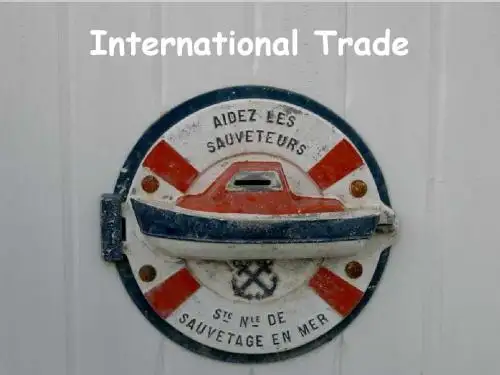
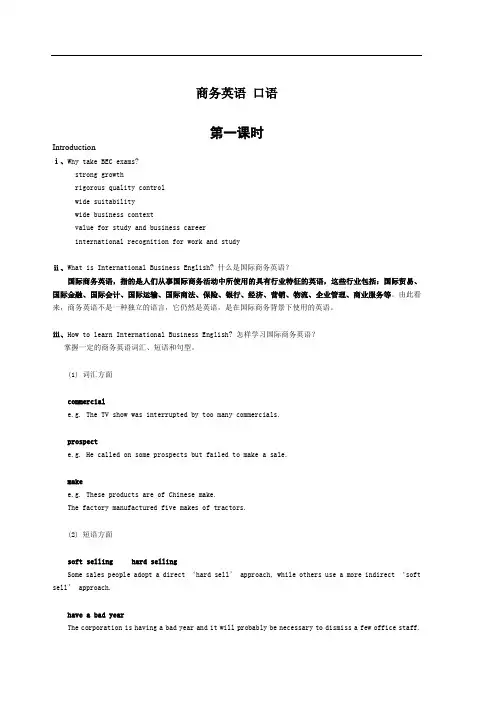
商务英语口语第一课时Introductionⅰ、Why take BEC exams?strong growthrigorous quality controlwide suitabilitywide business contextvalue for study and business careerinternational recognition for work and studyⅱ、What is International Business English? 什么是国际商务英语?国际商务英语,指的是人们从事国际商务活动中所使用的具有行业特征的英语,这些行业包括:国际贸易、国际金融、国际会计、国际运输、国际商法、保险、银行、经济、营销、物流、企业管理、商业服务等。
由此看来,商务英语不是一种独立的语言,它仍然是英语,是在国际商务背景下使用的英语。
ⅲ、How to learn International Business English? 怎样学习国际商务英语?掌握一定的商务英语词汇、短语和句型。
(1) 词汇方面commerciale.g. The TV show was interrupted by too many commercials.prospecte.g. He called on some prospects but failed to make a sale.makee.g. These products are of Chinese make.The factory manufactured five makes of tractors.(2) 短语方面soft selling hard sellingSome sales people adopt a direct ‘hard sell’ approach, while others use a more indirect ‘soft sell’ approach.have a bad yearThe corporation is having a bad year and it will probably be necessary to dismiss a few office staff.break into/penetrate the marketThere is chance that we’ll manage to break into the UK market(3) 句型方面I am writing to you concerning… You can’t miss it. I can’t agree more. It may have slipped your mind, but… You can always reach me at the number… We would very much appreciate it if you could…I noted with interest your advertisement for… Yes, that’s true, but on the other hand… That’s exactly what I think. Maybe, but don’t you think…? You are wanted on the phone. As req uested, we enclose for your attention…(4) 旧词“新义“honoure.g, All credit cards honoured here. The bank honoured this cheque.covere.g. I have got myself covered against fire.royaltye.g. Besides copyright, the writer got a 10 percent royalty on sales. The technology transfer fee shall be paid in royalties.(5) 同义词、近义词、相似词的辨析。

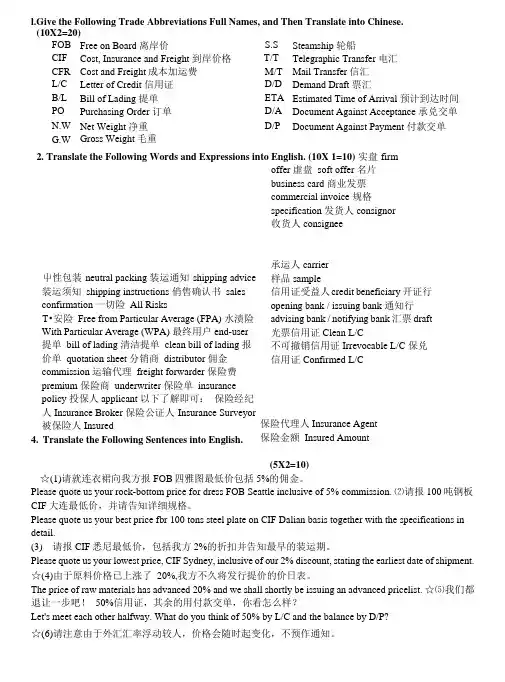
l.Give the Following Trade Abbreviations Full Names, and Then Translate into Chinese.(10X2=20)FOB Free on Board 离岸价 S.S Steamship 轮船CIF Cost, Insurance and Freight 到岸价格 T/T Telegraphic Transfer 电汇CFR Cost and Freight 成本加运费 M/T Mail Transfer 信汇L/C Letter of Credit 信用证 D/D Demand Draft 票汇B/L Bill of Lading 提单 ETA Estimated Time of Arrival 预计到达时间PO Purchasing Order 订单 D/A Document Against Acceptance 承兑交单N.W Net Weight 净重 D/P Document Against Payment 付款交单G.W Gross Weight 毛重屮性包装 neutral packing 装运通知 shipping advice装运须知 shipping instructions 俏售确认书 salesconfirmation 一切险 All RisksT •安险 Free from Particular Average (FPA) 水渍险With Particular Average (WPA) 最终用户end-user提单 bill of lading 清洁提单 clean bill of lading 报价单 quotation sheet 分销商 distributor 佣金commission 运输代理 freight forwarder 保险费premium 保险商 underwriter 保险单 insurancepolicy 投保人applicant 以下了解即可: 保险经纪人Insurance Broker 保险公证人 Insurance Surveyor被保险人Insured4. Translate the Following Sentences into English. Please quote us your rock-bottom price for dress FOB Seattle inclusive of 5% commission. ⑵请报100吨钢板CIF 大连最低价,并请告知详细规格。

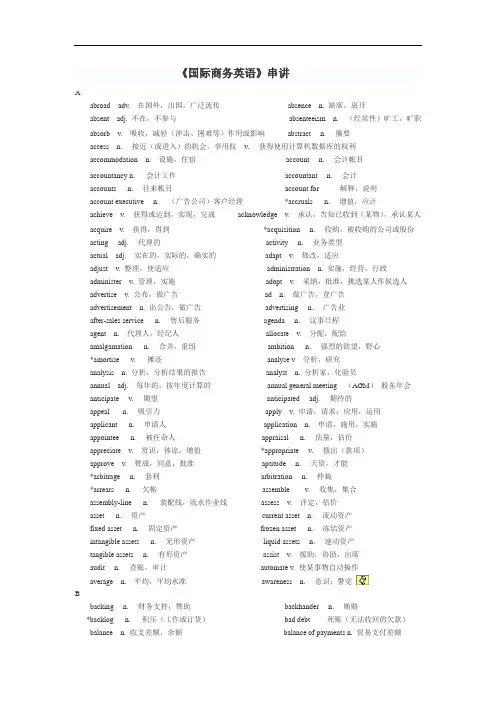
《国际商务英语》串讲Aabroad adv. 在国外,出国,广泛流传absence n. 缺席,离开absent adj. 不在,不参与absenteeism n. (经常性)旷工,旷职absorb v. 吸收,减轻(冲击、困难等)作用或影响abstract n. 摘要access n. 接近(或进入)的机会,享用权v. 获得使用计算机数据库的权利accommodation n. 设施,住宿account n. 会计帐目accountancy n. 会计工作accountant n. 会计accounts n. 往来帐目account for 解释,说明account executive n. (广告公司)客户经理*accruals n. 增值,应计achieve v. 获得或达到,实现,完成acknowledge v. 承认,告知已收到(某物),承认某人acquire v. 获得,得到*acquisition n. 收购,被收购的公司或股份acting adj. 代理的activity n. 业务类型actual adj. 实在的,实际的,确实的adapt v. 修改,适应adjust v. 整理,使适应administration n. 实施,经营,行政administer v. 管理,实施adopt v. 采纳,批准,挑选某人作候选人advertise v. 公布,做广告ad n. 做广告,登广告advertisement n. 出公告,做广告advertising n. 广告业after-sales service n. 售后服务agenda n. 议事日程agent n. 代理人,经纪人allocate v. 分配,配给amalgamation n. 合并,重组ambition n. 强烈的欲望,野心*amortise v. 摊还analyse v 分析,研究analysis n. 分析,分析结果的报告analyst n. 分析家,化验员annual adj. 每年的,按年度计算的annual general meeting (AGM)股东年会anticipate v. 期望anticipated adj. 期待的appeal n. 吸引力apply v. 申请,请求;应用,运用applicant n. 申请人application n. 申请,施用,实施appointee n. 被任命人appraisal n. 估量,估价appreciate v. 赏识,体谅,增值*appropriate v. 拨出(款项)approve v. 赞成,同意,批准aptitude n. 天资,才能*arbitrage n. 套利arbitration n. 仲裁*arrears n. 欠帐assemble v. 收集,集合assembly-line n. 装配线,流水作业线assess v. 评定,估价asset n. 资产current asset n. 流动资产fixed asset n. 固定资产frozen asset n. 冻结资产intangible assets n. 无形资产liquid assets n. 速动资产tangible assets n. 有形资产assist v. 援助,协助,出席audit n. 查账,审计automate v. 使某事物自动操作average n. 平均,平均水准awareness n. 意识;警觉Bbacking n. 财务支持,赞助backhander n. 贿赂*backlog n. 积压(工作或订货)bad debt 死账(无法收回的欠款)balance n. 收支差额,余额balance of payments n. 贸易支付差额balance sheet n. 资产负债表bankrupt adj. 破产的bankruptcy n. 破产bank statement n. 银行结算清单(给帐户的),银行对账单bar chart n. 条形图,柱状图bargain v. 谈判,讲价base n. 基地,根据地batch n. 一批,一组,一群batch production 批量生产bear market n. 熊市beat v. 超过,胜过behave v. 表现,运转behaviour n. 举止,行为,运转情况below-the-line advertising 线下广告,尚未被付款的广告benchmark n. 衡量标准benefit n. 利益,补助金,保险金得益fringe benefits n. 附加福利sickness benefit n. 疾病补助费bid n. 出价,投标takeover bid n. 盘进(一个公司)的出价bill n. 账单,票据billboard n. (路边)广告牌,招贴板black adj. 违法的in the black 有盈余,贷方black list 黑名单,禁止贸易的(货物、公司及个人)名单black Monday n. 黑色星期一,指1987年10月国际股票市场崩溃的日子blue chips n. 蓝筹股,绩优股blue-collar adj. 蓝领(工人)的Board of Directors n. 董事会Bond n. 债券bonus n. 津贴,红利books n. 公司帐目book value n. 账面价值,(公司或股票)净值bookkeeper n. 簿记员,记帐人boom n. 繁荣,暴涨boost v. 提高,增加,宣扬bottleneck n. 瓶颈,窄路,阻碍bottom adj. 最后的,根本的v. 到达底部,建立基础bounce v. 支票因签发人无钱而遭拒付并退回brainstorm n./v. 点子会议,献计献策,头脑风暴branch n. 分支,分部brand n. 商标,品牌brand leader n. 占市场最大份额的品牌,名牌brand loyalty n. (消费者)对品牌的忠实break even v. 收支相抵,不亏不盈break even point 收支相抵点,盈亏平衡点breakthrough n. 突破brief n. 摘要brochure n. 小册子broker n. 经纪人,代理人bull market 牛市budget n. 预算bulk n. 大量(货物)adj. 大量的bust adj. 破了产的buyout n. 买下全部产权CCAD(=Computer Aided Design)n. 计算机辅助设计call n. 打电话call on v. 呼吁,约请,拜访campaign n. 战役,运动candidate n. 求职者,候选人canteen n. 食堂canvass v. 征求意见,劝说capacity n. 生产额,(最大)产量caption n. 照片或图片下的简短说明capital n. 资本,资金capture v. 赢得cash n. 现金,现付款v. 兑现cash flow n. 现金流量case study n. 案例分析catalogue n. 目录,产品目录catastrophe n. 大灾难,大祸CEO n. Chief Executive Officer(美)总经理chain n. 连锁店challenger n. 挑战者channel n. (商品流通的)渠道charge n. 使承担,要(价),把……记入(账册等)chart n. 图表checkout n. 付款台chief adj. 主要的,首席的,总的CIF, c.i.f. 成本保险费加运费circular n. 传阅的小册子(传单等)circulate v. 传阅claim n./v. 要求,索赔client n. 委托人,顾客cold adj. 没人找上门来的,生意清淡的commercialise v. 使商品化commission n. 佣金*commitment n. 承诺commodity n. 商品,货物company n. 公司limited (liability)company (ltd.)股份有限公司public limited company (plc)n. 股票上市公司compensate v. 补偿,酬报compensation n. 补偿,酬金compete v. 比赛,竞争competition n. 比赛,竞争competitor n. 竞争者,对手competitive adj. 竞争性的component n. 机器元件、组件、部件,部分concentrated marketing n. 集中营销策略condition n. 条件,状况*configuration n. 设备的结构、组合conflict n. 冲突,争论*conglomerate n. 综合商社,多元化集团公司*consolidate v. 帐目合并*consortium n. 财团constant adj. 恒定的,不断的,经常的consultant n. 咨询人员,顾问,会诊医生consumables n. 消耗品consumer durables n. 耐用消费品(如:洗衣机)consumer goods n. 消费品,生活资料*contingency n. 意外事件continuum n. 连续时间contract n. 合同,契约contractor n. 承办商,承建人contribute v. 提供,捐献contribution n. 贡献,捐献,税conversion n. 改装,改造conveyor n. 运送,传递,转让core time n. (弹性工作制的)基本上班时间(员工于此段时间必须上班,弹性只对除此以外的时间有效)cost n. 成本fixed costs 固定成本running costs 日常管理费用variable costs 可变成本cost-effective adj. 合算的,有效益的costing n. 成本计算,成本会计credit n. 赊购,赊购制度credit control 赊销管理(检查顾客及时付款的体系)letter of credit 信用证credit limit 赊销限额credit rating 信贷的信用等级,信誉评价creditor n. 债权人,贷方*creditworthiness n. 信贷价值,信贷信用crisis n. 危机,转折点critical adj. 关键的*critical path analysis n. 关键途径分析法currency n. 货币,流通current adj. 通用的,现行的Current account 往来帐户,活期(存款)户current assets n. 流动资产current liabilities n. 流动负债customise v. 按顾客的具体要求制造(或改造等);顾客化cut-throat adj. 残酷的,激烈的cut-price a. 削价(出售)的CV(=curriculum vitae)n. 简历,履历*cycle time n. 循环时间Ddamages n. 损害,损失deadline n. 最后期限deal n. 营业协议,数量v. 交易dealer n. 商人debit n. 借方,欠的钱v. 记入帐户的借方debt n. 欠款,债务to get into debt 负债to be out of debt 不欠债to pay off a debt 还清债务debtor n. 债务人aged debtors 长期债务人declare v. 申报,声明decline n./v. 衰退,缓慢,下降decrease v. 减少deduct v. 扣除,减去default n. 违约,未履行defect n. 缺陷defective adj. 有缺点的defer v. 推迟deferred payments n. 延期支付deficit n. 赤字delivery cycle n. 交货周期*demand management n. 需求规化demotivated adj. 消极的,冷谈的deposit n. 储蓄,预付(定金)depot n. 仓库depreciate v. 贬值,(对资产)折旧depressing adj. 令人沮丧的deputy n. 代理人,副职,代理devalue v. 货币贬值(相对于其它货币)diet n. 饮食,食物,特种饮食differentiation n. 区分,鉴别dimensions n. 尺寸,面积,规模direct v 管理,指导director n. 经理,主管Managing Director n. 总经理direct cost n. 直接成本direct mail n. (商店为招揽生意而向人们投寄的)直接邮件direct selling n. 直销,直接销售directory n. 指南,号码簿discount n. 折扣,贴现dismiss v. 让……离开,打发走dismissal n. 打发走dispatch n./v. 调遣display n./v. 展出,显示dispose v. 安排,处理(事务)dispose of 去掉,清除distribution n. 分配,分发,分送产品*diversify v. 从事多种经营;多样化divest v. 剥夺dividend n. 股息,红利,年息division n. 部门*dog n. 滞销品down-market a./ad. 低档商品的*down-time/downtime n. 设备闲置期DP(=Data Processing)n. 计算机数据处理,计算机数据处理部门dramatic adj. 戏剧性的drive n. 积极性,能动性due adj. 应付的,预期的dynamic adj. 有活力的Eearnings n. 工资efficiency n. 效率endorse v. 背书,接受engage v. 雇用entitle v. 授权entitlement n. 应得的权利holiday entitlement n. 休假权equity n. 股东权益equity capital n. 股本equities 普通股,股票estimated demand n. 估计需求evaluate v. 估价,评价eventual adj. 最终的exaggerate v. 夸张exceed v. 超过exhibit n. 展览,表现expenditure n. 花费,支出额expense n. 费用,支出expense account n. 费用帐户expenses n. 费用,业务津贴expertise n. 专长,专门知识和技能*exposure n. 公众对某一产品或公司的知悉;广告所达到的观众总数Ffacilities n. 用于生产的设备、器材facilities layout n. 设备的布局规化、计划facilities location n. 设备安置*factoring n. 折价购买债券*fail-safe system n. 安全系统feasibility study n. 可行性研究feedback n. 反馈,反馈的信息field n. 办公室外边,具体业务file n. 文件集,卷宗,档案,文件v. 把文件(或资料)归档fill v. 充任finance n. 资金,财政v. 提供资金financial adj. 财政的financing n. 提供资金,筹借资金finished goods n. 制成品firm n. 公司fire v. 解雇fix v. 确定,使固定在fix up v. 解决,商妥fiscal adj. 国库的,财政的*flagship n. 同类中最成功的商品,佼佼者flexible adj. 有弹性的,灵活的flextime n. 弹性工作时间制flier(=flyer)n. 促销传单float v. 发行股票flop n. 失败flow shop n. 车间fluctuate v. 波动,涨落,起伏FOB, f.o.b n. 离岸价*follow-up n. 细节落实,接连要做的事forecast v. 预测four P's 指产品PRODUCT、价格PRICE、地点PLACE、促销PROMOTIONframework n. 框架,结构*franchise n. 特许经销权v. 特许经销,给予特许经销权franchisee n. 特许经营人franchiser n. 授予特许经营权者fraud n. 欺骗*freebie n. (非正式的)赠品,免费促销的商品freelance n.& adj. 自由职业者(的)funds n. 资金,基金futures n. 期货交易Ggap n. 缺口,空隙*gearing n. 配称(即定息债务与股份资本之间的比率)*gimmick n. 好主意,好点子goal n. 目标going adj. 进行的,运转中的going rate n. 产品的市场价格goods n. 货物,商品goodwill n. 声誉*go public v. 首次公开发行股票grapple with v. 与……搏斗,尽力解决grievance n. 申诉,抱怨gross adj. 总的,毛的gross margin n. 毛利率gross profit n. 毛利gross yield n. 毛收益gradually adv. 逐渐地group n. (由若干公司联合而成的)集团grow v. 增长,扩大growth n. 增长,发展guarantee n. 保证,保单guidelines n. 指导方针,准则Hhand in v. 呈送hand in one's notice 递交辞呈handle v. 经营*hands on adj. 有直接经验的hard sell n. 强行推销hazard n. 危险,危害行为head n. 主管,负责health and safety n. 健康和安全*hedge n. 套期保值hidden adj. 隐藏的,不明显的hierarchy n. 等级制度,统治集团,领导层hire v. 雇用hire purchase n. 分期付款购物法hit v. 击中,到达holder n. 持有者holding company n. 控股公司hostile adj. 不友好的,恶意的HRD n. 人力资源发展部human resources n. 人力资源Iimpact n. 冲击,强烈影响implement v. 实施,执行implication n 隐含意义incentive n. 刺激;鼓励income n. 工资或薪金收入,经营或投资的收入earned income 劳动收入,劳动所得unearned income 非劳动收入,投资所得increment v. 定期增加incur v 招致,承担*indemnity n. 偿还,赔偿index n. 指数,索引retail price index 零售价格指数indirect costs n. 间接成本induction n. 就职industrial adj. 工业的industrial action n. (罢工、怠工等)劳工行动industrial relations n. 劳资关系inefficiency n. 低效率,不称职inflate v. 抬高(物价),使通货等)膨胀inflation n. 通货膨胀*infringe v. 违法,违章initial adj. 初步的innovate v. 革新input n. 投入insolvent adj. 无清偿力的installment n. 部分,分期付款insure v. 给……保险,投保insurance n. 保险interest n. 利息,兴趣interest rate n. 利率interim n. 中期,过渡期间intermittent production n. 阶段性生产interview n./v. 面试interviewee n. 被面试的人interviewer n. 主持面试的人,招聘者introduce v. 介绍,提出*inventory n. 库存buffer inventory n. 用于应付突发性需求的存货capacity inventory n. 用于将来某时使用的存货cycle inventory n. 循环盘存decoupling inventory n. 保险性存货(以应付万一)finished goods inventory n. 制成品存货(盘存)pipeline inventory n. 在途存货raw materials inventory n. 原材料存货work-in-progress inventory n. 在制品盘存(存货)invest v. 投资investment n. 投资investor n. 投资者invoice n. 发票v. 给(某人)开发票irrevocable adj. 不可撤消的,不能改变的issue n. 发行股票* rights issue n. 优先认股权IT=Information Technology 信息技术item n. 货物,条目,条款Jjob n. 工作job description 工作说明,职务说明*job lot n. 一次生产的部分或少数产品job mobility 工作流动job rotation 工作轮换job satisfaction 工作的满意感(自豪感)*job shop n. 专门车间jobbing n. 为一次性的或小的订货需求而特设的生产制度joint adj. 联合的joint bank account (几个人的)联合银行存款帐户journal n. 专业杂志*jurisdiction n. 管辖(权)junk bonds n. 低档(风险)债券,垃圾债券junk mail n. (未经收信人要求的)直接邮寄的广告宣传*just-in-time n. 无库存制度Kkey adj. 主要的,关键的knockdown adj. (价格)很低的know-how n. 专门技术Llabel n. 标签,标牌v. 加标签,加上标牌labour n. 劳动,工作,劳动力labour market 劳动力市场labour relations 劳资关系labour shortage 劳动力短缺*launch v. 在市场推出一种新产品n. 新产品的推出lay-off/layoff n./v. 临时解雇layout n. 工厂的布局lead v. 领先,领导lead time n. 完成某项活动所需的时间leaflet n. 广告印刷传单lease n. 租借,租赁物legal adj. 合法的lend v. 出借,贷款lessee n. 承租人lessor n. 出租人*ledger n. 分类帐nominal ledger n. 记名帐purchase ledger n. 进货sales ledger n. 销货帐*leverage n. 杠杆比率liability n. 负债liabilities n. 债务licence(US:license)n. 许可证license v. 许可,批准life cycle n. 寿命周期likely adj. 可能的*line process 流水线(组装)link n. 关系,联系,环liquid adj. 易转换成现款的liquidate v. 清算*liquidity n. 拥有变现力liquidation n. 清理(关闭公司),清算liquidator n. 清算人,公司资产清理人listed adj. 登记注册的listing n. 上市公司名录literature n. (产品说明书之类的)印刷品,宣传品litigate v. 提出诉讼loan n./v. 贷款,暂借logo n. 企业的特有标记lose v. 亏损loser n. 失败者loss n. 损失lot n. 批,量loyalty n. 忠诚,忠实Mmagazine n. 杂志,期刊mailshot n. 邮购maintain v. 维持,保持maintenance n. 维持,坚持major adj. 重大的,主要的,较大的majority shareholding 绝对控股make n. 产品的牌子或型号make-to-order adj. 根据订货而生产的产品make-to-stock adj. 指那些在未收到订货时就已生产了的产品management n. 管理,管理部门middle management n. 中层管理人员senior management n. 高层管理人员managerial adj. 管理人员的,管理方面的manager n. 经理plant manager n. 工厂负责人line manager n. 基层负责人staff manager n. 部门经理助理management accounts n. 管理帐目matrix management n. 矩阵管理*management information system(MIS)n. 管理信息系统manning n. 人员配备manpower n. 劳动力manpower resources n. 劳动力资源manual adj. 体力的,人工的,蓝领的manufacture v. (用机器)制造manufacturer n. 制造者(厂、商、公司)manufacturing adj. 制造的manufacturing industry 制造业margin n. 利润gross margin n. 毛利率net margin n. 净利润mark-up v. 标高售价,加价market n. 市场;产品可能的销量down market adv./adj. 低档商品/地的up market adj./adv. 高档商品的/地marketing mix n. 综合营销策略,指定价、促销、产品等策略的配合market leader n. 市场上的主导公司*market niche n. 小摊位,专业市场的一个小部分1、国际贸易一般指不同国家的当事人进行的交易,它涉及到许多因素,因而此国内贸易要复杂得多。
《国际商务谈判》串讲资料〔课程代码:00186〕第一章国际商务谈判概述一、学习目的与要求作为国际经济活动的关键环节之一,国际商务谈判对企业的微观利益和国家的宏观利益都起着举足轻重的作用。
本章介绍了国际商务谈判的基本概念、特点、种类和基本流程,以及我国开展国际商务谈判的基本原则。
在此基础上,还深入探讨了国际商务谈判的主要模式。
应考者应牢记国际商务活动的特殊性,严格遵守国际管理和相关法律,切实领会国家利益高于一切的真正内涵。
二、考核内容〔一〕国际商务谈判的定义〔二〕国际商务谈判的特点〔三〕按参加谈判的人数规模来划分谈判的种类〔四〕按参加谈判的利益主体的数量的不同来划分谈判的种类〔五〕按谈判双方接触的方式来划分谈判的种类〔六〕按谈判进行的地点不同来划分谈判的种类〔七〕按谈判中双方所采取的态度与方针来划分〔八〕按谈判的内容不同来划分谈判的种类〔九〕我国国际商务谈判的基本原则〔十〕国际商务谈判的基本程序〔十一〕国际商务谈判的PRAM模式三、重点难点〔一〕国际商务谈判的内涵和特点〔二〕国际商务谈判的基本流程〔三〕国际商务谈判的主要类型四、知识点串讲第一节国际商务谈判的概念及特点〔一〕国际商务谈判的定义1. 谈判〔negotiation〕所谓谈判是指参与各方基于某种需要,彼此进行信息交流,磋商协议,旨在协调器相互关系,赢得或维护各自利益的行为过程。
2. 商务谈判〔business negotiation〕商务谈判主要集中在经济领域,指参与各方为了协调、改善彼此的经济关系,满足贸易的需求,围绕标的物的交易条件,彼此通过信息交流、磋商协议到达交易目的的行为过程。
3. 国际商务谈判〔international business negotiation〕国际商务谈判是指在国际商务活动中,处于不同国家或不同地区的商务活动当事人为了达成某笔交易,彼此通过信息交流,就交易的各项要件进行协商的行为过程。
〔二〕国际商务谈判的特点1. 国际商务谈判具有一般贸易谈判的共性〔1〕以经济利益为谈判的目的〔2〕以经济利益作为谈判的主要评价指标〔3〕以价格作为谈判的核心2. 国际商务谈判的特殊性〔1〕国际商务谈判既是一笔交易的商洽,也是一项涉外活动,具有较强的政策性〔2〕应按国际惯例办事〔3〕国际商务谈判内容广泛〔4〕影响谈判的因素复杂多样第二节国际商务谈判的种类〔一〕国际商务谈判的种类1. 按参加谈判的人数规模来划分,可以将谈判分为谈判双方各只有一人参加的一对一的个体谈判,以及各方都有多人参加的集体谈判。
International Business EnglishLesson 1International BusinessBusiness Knowledge:The major differences between international business and domestic businessA.Differences in legal systemsB.Differences in currenciesC.Differences in cultural backgroundD.Different in natural and economic conditionsThe major types of international businessA. Trademodity tradeb.Service tradeB. Investmenta.Foreign direct investmentb.Portfolio investmentC. Other typesa.Licensing and franchisingb.Management contract and contract manufacturingc.Turnkey project and BOTTrade Terms:1.Customs area关税区:2.Conversion货币兑换3.Visible trade有形贸易: The form of commodity trade, i.e. exporting and importing goods produced or manufactured in one country for consumption or resale in another. (including cash transaction-bymeans of money and market, and counter trade)4.Invisible trade无形贸易: The form of transportation, communication, banking, insurance, consulting, information etc. is called invisible trade or service industries.5.FDI外国直接投资: Foreign direct investments. Returns through controlling the enterprises or assets invested in a host country. / P.256. One country acquires assets in a foreign country for the purpose ofcontrolling and managing them.6.Portfolio investment证券投资: Purchases of foreign financial assets for a purpose other than controlling.7.Stocks股票: Capital stocks or bonds.8.Bonds债券: The papers issued by a government or a firm with promise to pay back the money lent or invested together with interest.9.Maturity(票据等)到期10.Certificate of deposit大额存单11.Licensing许可经营: In licensing, a firm leases the right to use its intellectual property to a firm in another country. They choose licensing because they do not have to make cash payments to statbusiness, and can simply receive income in the form of royalty.12.Franchising特许经营: Under franchising, franchisee is allowed to operate in the name of another, franchiser who provides the former with trademarks, brand names, logos and operating techniques forroyalty.13.Trade Mark商标14.Patent专利15.Royalty专利(许可)使用费,版税16.Copyright版权17.Licenser许可方18.Licensee被许可方19.Franchiser特许方: A firm who provides the franchisee with trademarks, brand names, logos and operating techniques for royalty.20.Franchisee被特许方: A firm is allowed to operate in the name of another.21.Management contract管理合同: Under a management contract, one company offers managerial or other specialized services to another within a particular period for a flat payment or a percentage ofthe relevant business volume.22.Value chain价值链23.Turnkey project“交钥匙”工程: For an international turnkey project, a firm signs a contract with a foreign purchaser and undertakes all the designing, contracting and facility equipping before handingit over to the latter upon completion.24.BOT建设、经营和移交: Build, Operate, Transfer25.Expertise专门知识26.Bonus红利、奖金、津贴27.Royalty 许可使用费28.International investment国际投资: Supplying capital by residents of one country to another.29.Contract manufacturing承包生产30.GATT关贸总协定: General Agreement on Tariffs and Trade31.International business国际商务: Transaction between parties from different countries. Sometimes business across the borders of different customs areas of the same country is also regarded as importand export.32.Intellectual property知识产权33.Oil deposit: 石油储备= oil reserves34.the reserves of natural resources 自然资源储备35.Personal advancement个人的晋升,个人素质的提高以及个人事业的进步等。
经贸知识英语串讲讲义第一课1)How would you define international trade?Answer: 第三页第一段第一句。
2)How did international trade first begin?Answer: The distribution of natural resources is uneven. That is the reason why international trade first began.3)What is the new incentive for trade that arose with the development of manufacturing and technology?Answer: 第三页第二段(international specialization)。
4)Explain the theory of absolute advantage and its application in international trade.Answer: If a country is more efficient, or spends less resources such as capital, land and labor than other countries in producing a commodity, we say this country has an absolute advantage in producing this commodity. The theory of absolute advantage implies that every country produces and exports commodities in which they have absolute advantage while importing commodities where other countries have absolute advantage. (参看第三页第四段到第四页第二段结束)5)Who introduced the theory of comparative advantage? Which theory makes more sense, absolute advantage or comparative advantage?Answer: The English economist David Ricardo did. The theory of comparative advantage makes more sense than that of absolute advantage.6)Explain briefly why trade to exploit comparative advantage promotes efficiency among countries.Answer: The theory of comparative advantage implies that every country, even when it has no absolute advantage at all, can specialize in the production and export of commodities where its absolute disadvantage is smaller or where it has comparative advantage. So long as comparative advantage exists, trade between countries is always possible, and in the process of exploiting comparative advantage, trade promotes efficiency among countries, since it can make one country better off without making another worse off.7)Is comparative advantage something static? Is it purely decided by the endowments of nature? Give examples to show the development of comparative advantage by certain countries. Answer: 第五页第三段全部。
第二课1)Are there other bases for trade when there are no differences among countries in production conditions? Mention some of the bases. Answer: Yes, there are. They are patterns of demand, economies of scale and innovation or style.2)What is economy of scale? What is the relation between economy of scale and trade? Answer: Trade will be developed between countries when economy of scale is practiced, that is, when different countries can specialize in production and export of different commodities and on a larger scale. And all countries can benefit. (参看第十五页第二段)3)What does the theory of international specialization seek to answer? Answer: 第十五页最后一段第一句。
4)Will complete specialization occur in reality? Why? Answer: Never. The reasons are the production of goods for strategic or domestic reasons by a country where it has no advantage, the transport cost that may reduce the benefit of trade, and the protectionist measures such as tariffs and quotas. (参看第十六页第二段)5)What is tariff barriers? What is a customs area and what is a customs union? Answer: Tariff barriers are the most common form of trade restriction, and a tariff is a tax levied on a commodity when it crosses the boundary of a customs area.A customs area usually refers to the area of a country. A customs area extending beyond national boundaries to include two or more independent nations is called a customs union. (参看第十六页第三段)6)What is most favoured nation treatment? Is it a very special treatment? Why? Answer: 第十六页最后一段倒数第四行到第十七页第一段结束。
7)What is the most common form of non-tariff barriers? Explain it in a few words. Answer: 第十七页第二段前6行。
8)What are the differences between visible trade and invisible trade? Give a few examples of invisible trade. Answer: Visible trade refers to the import and export of goods, while invisible trade refers to the exchange of services betweencountries. Transportation, insurance, tourism and immigrant remittance are examples of invisible trade.第三课1) Why is it difficult to effect payment in a straight forward manner in international trade? Answer: Because in international trade the buyer and the seller are located in different countries and they don’t know each other very well, therefore it’s no t so easy to effect payment in a straight forward manner as in domestic trade where the buyer and the seller are geographically close to each other and understand each other well.2) Mention some of the riskd the exporter and the importer may face in trade. Answer: 第二十九页第二、三段。